Despite its footballing heritage, Argentina has seen quite a few dark days in their long footballing history. They have lost the World Cup final three times, their superstar Diego Maradona has been suspended for drug use, they have suffered a 6-1 World Cup loss to Czechoslovakia, a 4-0 in a World Cup quarterfinal to Germany and even lost to archrivals Brazil in the 1982 edition.
Now Thursday’s game against Croatia can be added to that notorious list. The stakes may not have been as high, but the sight of a great footballing nation like Argentina being dismantled by Croatia was remarkable.
Nonetheless, Nigeria’s comprehensive victory over Iceland has given the Albiceleste hope of making the knockout stages. To do this, they will need to beat Nigeria- a game that may have seemed routine before the tournament but now feels like a coin flip.
After the thrashing against Croatia, manager Jorge Sampaoli will need to change his tactics if the Albiceleste are to progress into the Round of 16. His choice of a 3-4-2-1 vs Croatia proved disastrous as Argentina were exposed at the back and lacked tooth in attack.
While Argentina’ squad is ridiculously lopsided (amazing attack and mediocre midfield/defence), Sampaoli still has a number of tactical options open to him.
#5 Chile 2014: 3-4-1-2
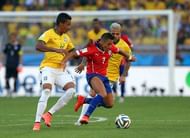
While Sampoali’s 3-4-2-1 was a massive failure vs Croatia, a three-man defence could still be an ideal option for the Argentine team with some changes in personnel and minor tactical tweaks as shown in the formation below (created courtesy of buildlineup.com):
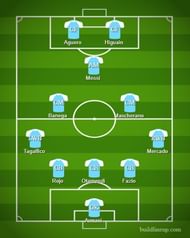
After all, Sampaoli has previously succeeded at the World Cup with Chile while playing a 3-4-1-2. The addition of a target man (Higuain) instead of an attacking midfielder (Meza) could be the change that Argentina needs. It would maintain Sampoali’s trademark “pressing” style- especially useful against Nigeria's inexperienced defence.
Furthermore, a shift in personnel could provide defensive solidity. Against Croatia, Sampaoli played two full-backs (Nicolas Tagalfico and Gabriel Mercado) in central defence and two wingers (Eduardo Salvio and Marcos Acuna) as wing-backs.
A better approach would be playing Tagalfico and Mercado as wingbacks while playing natural centre-backs Federico Fazio, Marcus Rojo and Nicolas Otamendi in central defence.
Rojo and Otamendi are both excellent passers while Fazio was among the best defenders in Serie A last season. Thus this defensive trio would have the right mix of passing and defensive ability.
Having Mercado and Tagalfico as wing-backs would also help nullify the threat of Ahmed Musa and Victor Moses: Nigeria's two most dangerous players. Such a defensive structure would help reduce the defensive vulnerabilities that proved fatal against Croatia.
This change in formation could also help Argentina’s attack as a stronger defence would enable Sampaoli to pick Ever Banega. When the midfielder was substituted on against Iceland, Argentina looked infinitely more dangerous due to Banega’s industrious style of play (strangely he did not feature against Croatia).
Banega’s excellent passing and ability to move the ball from defence to attack could reduce the pressure on Lionel Messi.
The little magician has been forced to play deep, preventing him from doing what he does best: creating chances for himself and his teammates. With Banega in the starting line up, Messi could play almost exclusively in the final third.
Finally, playing both central strikers in Higuain and Aguero would ensure that Argentina do not have to rely heavily on Messi for goal-scoring. Both Higuain and Aguero are excellent passers (both had six assists in their respective leagues in 2017-18) who could drop back when needed.
There are some issues associated with such a formation. Firstly, playing Mercado and Tagalfico as wing-backs would reduce the attacking threat from this position.
This formation would also result in a lack of width for the South American side- allowing Nigeria to defend compactly in the middle. Furthermore, if Nigeria continue to play three men in central midfield, Argentina would be outnumbered in the middle of the park.
These tactics are also unable to accommodate Paulo Dybala- perhaps Argentina’s second best player after Messi. Nonetheless, the formation’s defensive solidity along with the attacking threat of Messi, Higuain and Aguero together should make it a consideration for Sampaoli.
#4 Argentina 2014: 4-2-3-1
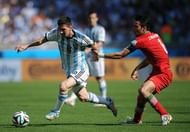
Sometimes it is the simplest formations that make the most sense. Almost every club in Europe played a 4-2-3-1 at some point in the season, with many relying on the formation exclusively.
Argentina themselves played that exact formation throughout the 2014 World Cup, as they used it to reach the final. An adaption of that formation (shown below) could be the correct move against Nigeria:
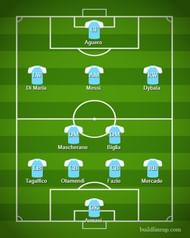
A four-man defence featuring Fazio and Otamendi in the centre and Mercado and Tagalfico wide is certainly solid. Moreover, unlike the aforementioned 3-4-1-2, this formation includes a defensive midfield pivot of Javier Mascherano and Lucas Biglia.
Biglia is more solid defensively (and in keeping possession) than Banega and is more likely to ensure that Nigeria don't dominate the midfield.
While using Biglia instead of Banega may result in a less industrious midfield, that is more than offset by the presence of Paulo Dybala. The Juventus forward is one of the most creative players in the World and his genius could help reduce the pressure on Messi. Dybala could stay exclusively in the final third, allowing Messi to roam freely to collect the ball from the midfield.
The collective play-making talents of Messi and Dybala would allow Angel Di Maria and Aguero to run behind the Nigerian defence- thus posing an irresistible attack. Finally, perhaps the biggest advantage of this formation remains its simplicity and familiarity. At a time where there have been reports of players being disenchanted with Sampoali’s muddled tactics, going back to basics may be the best option for Argentina.
Yet, that supposed strength of these tactics may also be its weakness. Argentina used the 4-2-3-1 formation in their first game against Iceland (albeit with different personnel- no Dybala) and still failed to break down the resilient Islanders.
The formation may have grown a little stale with opposition teams likely being aware of how specific Argentinian players (especially Messi) tend to play within this system.
Nigeria certainly will be aware considering they played Argentina at the last World Cup. Furthermore, these tactics may be problematic considering the use of Dybala as a right-winger. The Juventus forward likes to cut in and thus may not provide the requisite width to Argentina’s attack.
In addition, Dybala and Messi have had problems playing together in the past as they tend to occupy similar positions. These issues may continue in such a formation as Dybala’s tendency to cut in is likely to clash with Messi’s role as an attacking midfielder. Despite these problems, Argentina should at least consider 4-2-3-1 because of its clarity.
#3 Guardiola’s Barcelona: 4-3-3
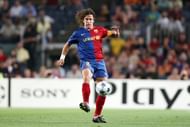
Speaking of formations in which Lionel Messi flourishes, 4-3-3 can never be disregarded. The 30 year old reached his peak playing in that formation for Pep Guardiola at Barcelona as the Blaugrana conquered Europe. Playing Messi at the right of a front three (as shown below) while still giving him the license to roam may be the magical “formula” for Argentina:
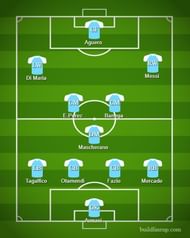
Angel Di Maria could (theoretically) be the creative yet pacey left-winger needed in such a formation (almost a poor man’s Neymar). Up front, Aguero’s poaching abilities along with his occasional creative tendencies are ideal for a target man in this formation.
In addition, the double pivot of Mascherano and Enzo Perez would allow Ever Banega to operate from an advanced position (thus making full use of his creative talents).
Having three men in midfield would also mean that Messi would not feel the need to drop back into midfield and could instead focus on chance creation.
Moreover, the formation would allow Argentina to match Nigeria (who also like to play with a 4-3-3 formation) thus allowing Albiceleste’s superior talent to prevail. Finally similarly to 4-2-3-1, 4-3-3 is a formation that most of the squad will be familiar with.
Despite being a relatively ‘safe’ formation for Argentina, 4-3-3 may not be perfect considering the form of some key players. The main problem is Angel Di Maria, who has had a terrible start to the World Cup- looking like a shadow of his usual self.
A below-par Di Maria would reduce the effectiveness of such a formation. Even more worryingly, Argentina do not have reliable options to replace the PSG player as both Dybala and Salvio play on the right.
Furthermore, Dybala cannot be accommodated into this formation- thus preventing Argentina from playing with their second best player. The midfield may also prove worrisome as Perez has struggled so far in the tournament- yet remains the only option for such a formation (adding Biglia would reduce the team’s attacking effectiveness).
After all, a midfield trio of "Banega, Perez and Mascherano" cannot match the quality of Guardiola's Xavi, Iniesta and Busquets. Even then, 4-3-3 remains a viable option for Sampaoli because of the freedom it provides Messi.
Follow Sportskeeda for 2018 World Cup Scores, Latest News & Updates, Match Analysis, Detailed Stats, Fantasy Tips, Controversies, Match Predictions and much more.
#2 Valverde’s Barcelona: 4-4-2
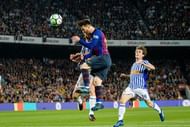
From the formation (Guardiola’s) that ended the reign of 4-4-2 to the one that threatens to bring it back. Ernesto Valverde has chosen a unique style at Barcelona, choosing to play an asymmetrical 4-4-2 with Messi functioning as a second striker behind Luis Suarez.
The asymmetry comes from the “left midfielder” (Iniesta) who is really a central-midfielder while the right winger (Dembele when fit) is an all-out winger.
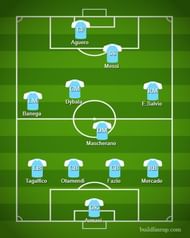
This formation would be ideal for Argentina simply because it would give Messi freedom to operate. After all, Messi had one of his best seasons last year for Barcelona as the Blaugrana almost went undefeated.
Aguero could replace Suarez as the out and out striker who still has the ability to create when needed. Salvio could replace Dembele as the hardworking winger while Banega could try and emulate Iniesta’s role in left midfield as shown in the below formation:
Where this really gets interesting is Paulinho’s replacement in attacking midfield. Instead of a physical specimen like the Brazilian, Argentina can use a creative genius like Dybala. While Dybala may not be able to contribute in a manner similar to Paulinho, he could instead use creativity to wreak havoc in Nigeria’s defence from a midfield position (similar to David Silva over the past season).
What makes this formation really interesting is the fact that Dybala and Messi could switch roles periodically between attacking midfield and second striker, thus causing confusion in the Nigerian defence.
This could be especially effective if a player like Wilfrid Ndidi is assigned to man-mark Messi- periodic positional changes may be the best way to evade such a man marker. Finally, such a formation would also be ideal for Salvio as he could surge forward from right-midfield with Aguero waiting in the middle.
Yet what makes this formation rather unrealistic is the idea of playing Dybala in central midfield. While his creative talents could flourish, the forward has never had to track back much throughout his career and relying on him to do so in such a crucial game may be foolish.
Moreover, someone like David Silva’s defensive issues in central midfield can be covered by the likes of Fernandinho. Mascherano may have been able to fulfil such a role in the past, yet relying on him to do so at this age is unrealistic.
Furthermore, playing Banega and Dybala out of position is again a huge gamble which may backfire on Sampaoli (as his earlier gambles have). Finally, Messi and Dybala’s issues may continue to persist. Despite this, Sampaoli still may want to consider copying Valverde’s formation.
#1 Two False Nines: 4-2-4
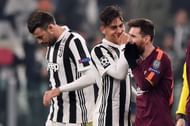
You’ve heard about the false nine- Messi has himself previously flourished in the role while playing for Barcelona. However, have you ever thought about playing two ‘false’ nines simultaneously? It could be an interesting experiment for Sampaoli to consider in the game against Nigeria. They could line up as the following:
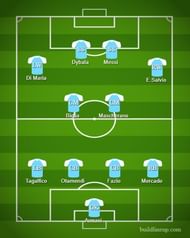
As one can see, the two ‘false nines’ would be Messi and Dybala, who could use their creative talents to generate chances for each other or the two overlapping wingers: Salvio and Di Maria. It would be a fearless attacking formation- the type that Argentina need in a must-win game (a draw would see them eliminated).
It would also solve the problem of Messi and Dybala playing together (drifting back into the same positions). When one would come to create in attacking midfield, the other could stay forward as the actual ‘No.9’ to finish off any possible chance. After all, both players are among the best finishers in the game right now. In addition, the lack of a traditional No.9 would open up space for them to flourish.
In addition similarly to 4-4-2, Salvio would be in his natural right-midfield position. While some may claim the formation is too attacking, the lack of threat posed by Nigeria’s fullbacks means that Argentina don’t really need their wingers to track back.
Instead, Nigeria’s threat is mainly through their wingers who would be neutralized by Tagalfico, Mercado along with the defensive midfield pivot of Mascherano and Biglia. Overall, this formation would be a modern (and less extreme) version of ‘Dutch total football’ where every player could take over the role of any other player.
Perhaps this is just utopian thinking- it seems absurd to exclude a traditional No.9 when you desperately need a win especially when you have two of the best in the world (Aguero and Higuain). Moreover, there is no link between the defensive midfield pivot and the false nines- one of whom would have to constantly drop back (this is where Banega would be useful but Biglia is needed for defensive purposes).
Nonetheless, if I was Sampaoli, I would try this formation- if only because it could one last final gamble. If it doesn’t work, Sampaoli will remain the most hated man in Argentina (you can’t drop lower than rock bottom). However, if it works, Sampaoli will restore his reputation as a tactical genius.
Follow Sportskeeda for 2018 World Cup Scores, Latest News & Updates, Match Analysis, Detailed Stats, Fantasy Tips, Controversies, Match Predictions and much more.
